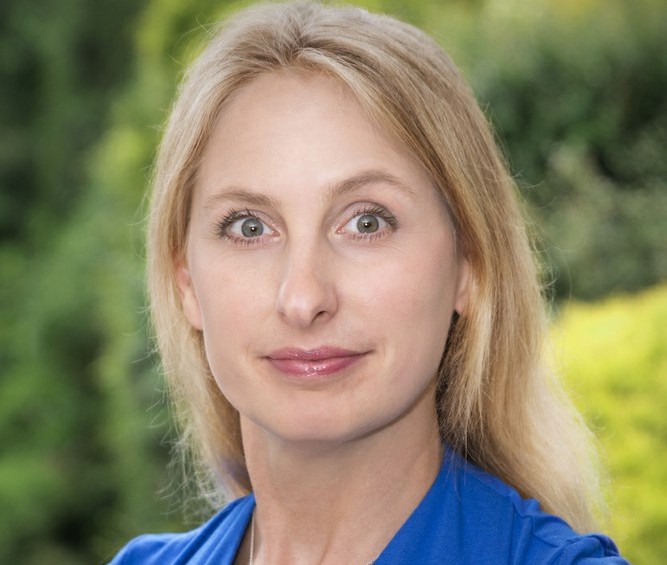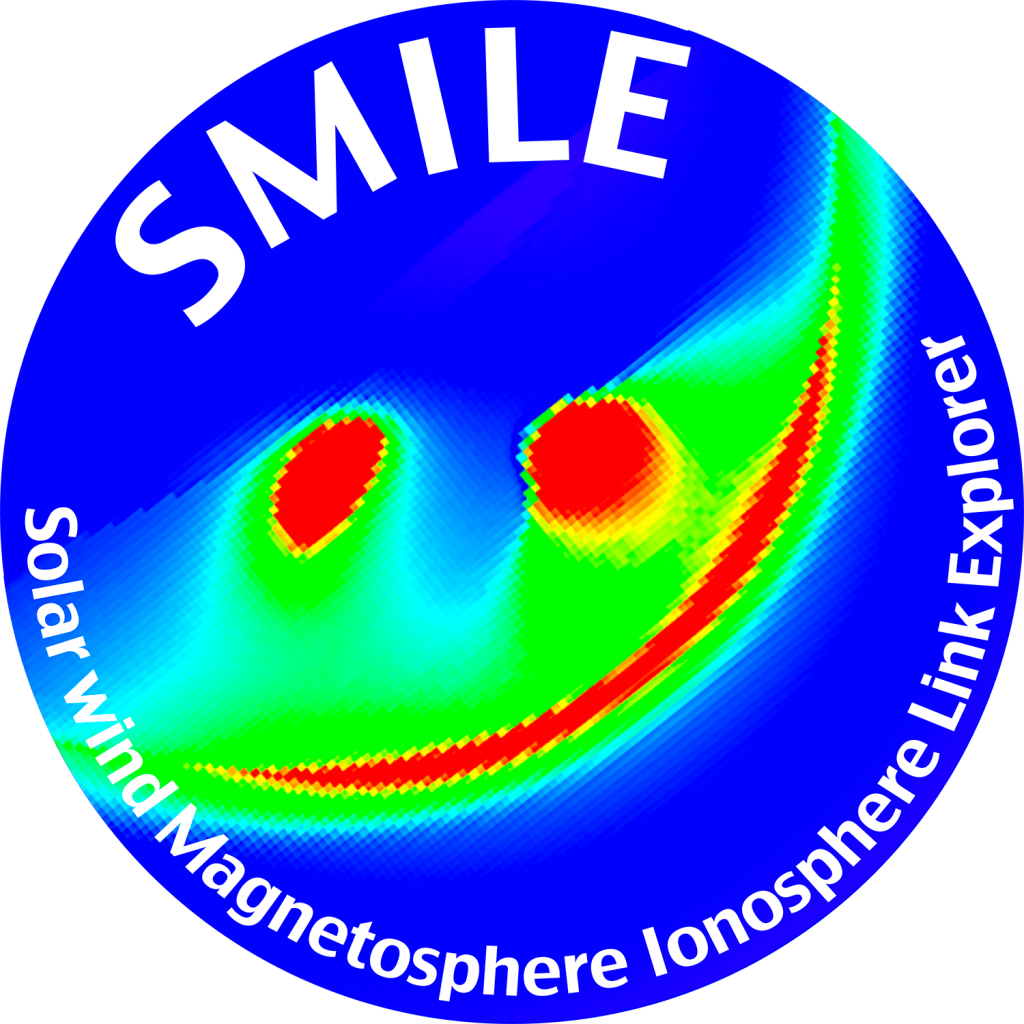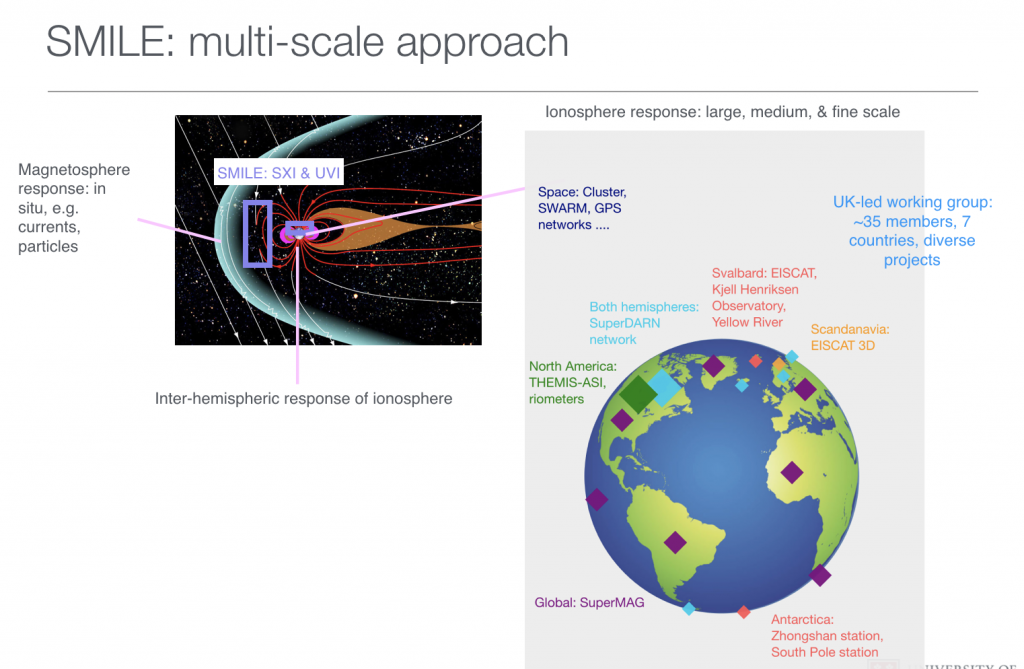Dr. Jenny Carter blogs about Leicester’s involvement in the Solar wind Magnetosphere Ionosphere Link Explorer (SMILE) mission, scheduled for launch in 2024.
In 2024 the Solar wind Magnetosphere Ionosphere Link Explorer (SMILE) will launch and give us a novel view of how the solar wind impinges on the Earth’s magnetosphere and how the high-altitude atmosphere or ionosphere responds as a result. Earth is somewhat protected in space by its magnetic field, or magnetosphere, but this gets buffeted and pummelled as the solar wind blows weaker or stronger. We often call the changes provoked in the Earth’s system to the incoming solar wind as “space weather”, and these effects are recognised as a significant potential hazard to UK infrastructure. Space weather is now included in the National Risk Register for Civil Emergencies, and is currently listed in the same risk category as an emerging disease.

SMILE is a mission being jointly prepared by the European Space Agency and Chinese Academy of Sciences, involving hundreds of scientists and engineers spread across the globe. SMILE will circle the Earth in a highly inclined and highly elliptical orbit, about a third of the way to the Moon at maximum distance, giving it an excellent vantage point of the magnetosphere. SMILE will carry four scientific instruments on board; two imagers, and two in situ instruments. One of the imagers, the Soft X-ray Imager or SXI, has a strong UK involvement and its build is being led by the University of Leicester with the support of UKSA. We take advantage of the considerable heritage in X-ray astronomical instrumentation at Leicester to optimise the SXI and its view of the dayside magnetosphere.

As SXI takes images of how the magnetopause, or frontier between the solar wind and Earth’s magnetosphere moves in and out and changes shape, the Ultraviolet Imager, or UVI, will take simultaneous images of how the aurora respond in the ionosphere in the Northern Hemisphere. The aurora, as viewed from a high vantage point in space, look much like an oval, but this oval expands and contracts, much like a lung breathing, in response to activity in the outer magnetosphere. By viewing both the magnetopause and the aurora at the same time, SMILE will give us an unprecedented view of how the magnetosphere and ionosphere connect and rearrange themselves in a cyclical manner. This is known as a substorm.
However, we don’t really know what provokes the substorm. We don’t understand how or whether larger geomagnetic storms are connected to the substorm. Does the shape of the magnetopause play a role, or what conditions have to happen in the solar wind for a substorm or larger geomagnetic storm to occur?

To obtain a truly global and multiscale picture of the substorm cycle to deeply probe these outstanding questions, SMILE must combine its findings with the context provided by other experiments, both ground and space-based. In May 2020, I was very privileged and happy to receive the L’Oréal-UNESCO For Women In Science UK and Ireland Rising Talents award in the Physical Sciences. Although we couldn’t meet in person this year, in preparation for the award interview I had the opportunity to virtually meet the other candidates from very different areas of science, and I hope we will have the chance to meet in person in the near future. With this award I am leading efforts to lay the foundations for a strong collaboration between an international group of scientists preparing to support SMILE, so that we can maximise the science we extract from the mission. This group of 35 scientists has come together as the SMILE Ground-based and Additional Science Working Group, and each of us represents one or more experiments that will support SMILE. We’re based in nine different countries, stretching from Japan in the east to Canada in the west. These experiments, both in a local and global sense, provide different perspectives on what occurs in the ionosphere and in near-Earth space as space weather rages further out into the magnetosphere. They work on various time and spatial scales and will allow us to really understand in exquisite detail how the large-scale phenomena as seen by SMILE relates to medium and smaller effects at the ionosphere. I’ll mention some of these diverse experiments here, although this is by no means an exhaustive list. SMILE will view the Northern Hemisphere only, as its orbit prevents any observations of the Southern Hemisphere during the perigee passage and which will instead be used to download data to ground stations on Earth. Ground-based and other spacecraft, however, can be used in conjunction with SMILE to give a dual-hemisphere picture of the substorm cycle, and probe important questions about any inter-hemispheric differences and asymmetries.
The Super Dual Radar Network (SuperDARN) is a large consortium of high-frequency coherent scatter radar operating in both hemispheres, with the majority of the radars observing the high-latitude Northern Hemisphere. SuperDARN measures plasma flows at short, two-minute resolution, and are used as evidence of both dayside driving by the incoming solar wind and nightside substorms. Other radars, such as EISCAT which will soon be joined by EISCAT 3D, give us very precise measurements of the upper atmosphere, but on smaller spatial scales. Support in the UK for these projects is provided by NERC.
The SuperMAG magnetometer network also operates on a global scale and has fantastic geographical spread. These magnetometers are used to measure levels of geomagnetic activity – through the production of magnetic indices that tell us how electrical currents are flowing around the Earth’s magnetosphere. These indices can be selected by latitude, so we can separate effects in the polar region from those most important at lower, equatorial latitudes.
We’re also looking at auroral imagers on the ground. These are cameras that look up at the sky and take pictures of the very fine structure of the aurora, sometimes will horizon-to-horizon fields of view. These cameras are placed in northly regions – there are many placed in the US, Canada, Finland, Norway, Sweden, and China, to name but a few. We work closely with our Chinese colleagues, who also run the Meridian project – which looks at geomagnetic and ionospheric activity in a coordinated chain along one line of longitude.
We will also join forces with other spacecraft mission investigating near Earth space. This includes experiments to measure electrical currents (e.g. Swarm) and in situ plasma measurements (e.g. Cluster) – although this is all dependent on which projects are operational during SMILE’s mission. We also hope that other missions that are currently being prepared or under study by other space agencies, will fly. This will give us a fantastic chance to obtain a stereoscopic view of the magnetosphere.
The opportunity to take our ideas forward, using the L’Oréal-UNESCO award, has come at a crucial point in my career. I initially started out as an X-ray astronomer and I spent several years as part of the European Space Agency’s XMM-Newton team. My PhD was relevant to SMILE, as I looked at how the Earth’s exosphere, or outer atmosphere, emits X-rays and how much of a signal and a problem this can create for telescopes such as XMM-Newton. My PhD opened up a pathway into a new field of science for me, and seven years ago I was given the opportunity by the University of Leicester to switch research fields and move into the area of magnetospheric-ionospheric coupling; investigating how the solar wind and interplanetary magnetic field affects the Earth’s magnetosphere. I have gradually built up a research record in my new field over the past few years, taking time off for a second maternity leave, and continuing to work part time. As part of the SMILE team I am able to tie up my two research threads.

Practically, the L’Oréal-UNESCO award allows me to develop scientific visualisation and analysis software to be used once SMILE launches, and to deliver a series of workshops and experiments with a cohort of local secondary school children who are following SMILE mission development with keen interest, and exploring the challenges, perseverance, and team work that a space mission requires. Personally, the award allows me to take my career to the next step and builds my leadership experience. I am honoured to chair the efforts to enhance and strengthen the ‘link’ in SMILE by engaging the wider solar-terrestrial community. SMILE will radically alter our view of the magnetosphere and space weather at Earth and I can’t wait for those first images to arrive.

 Subscribe to Physics & Astronomy's posts
Subscribe to Physics & Astronomy's posts
Recent Comments